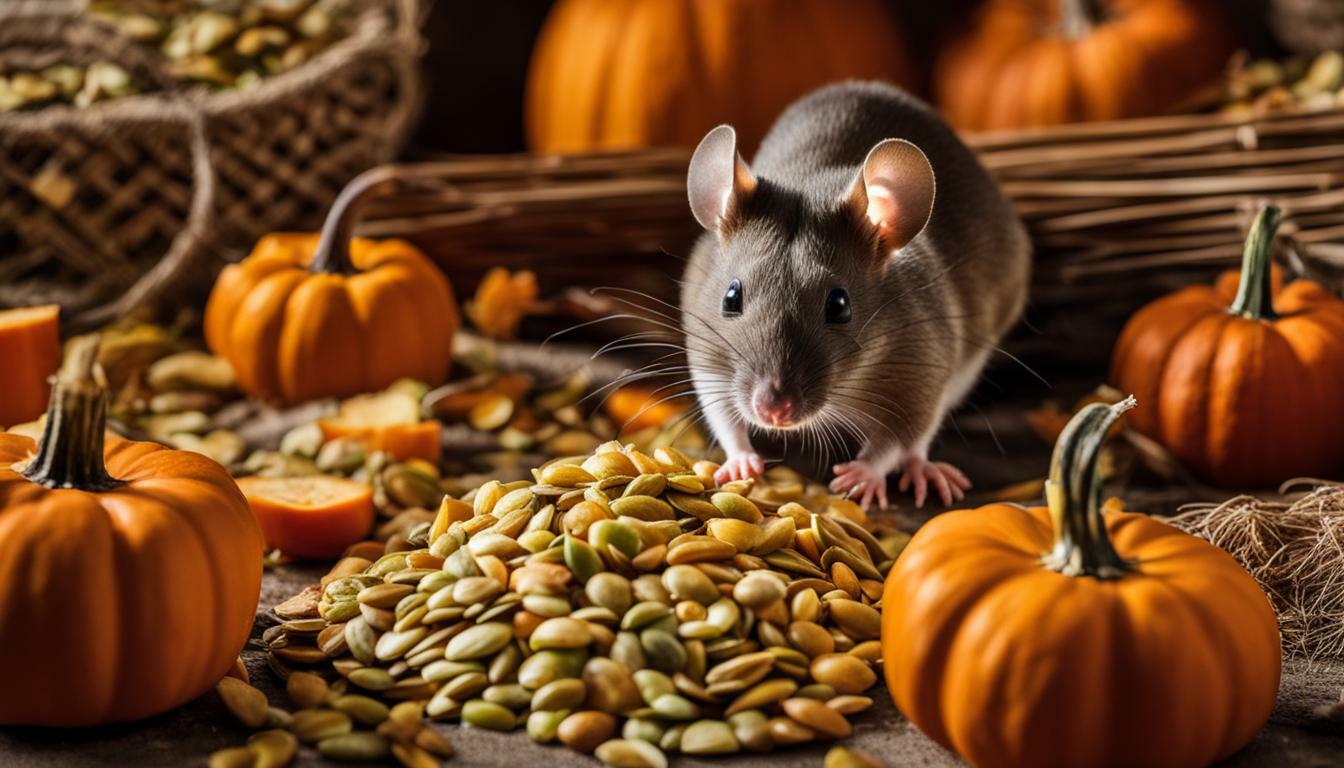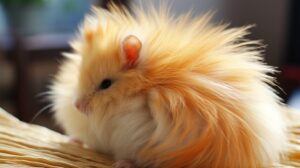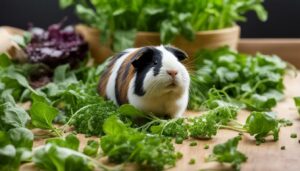Are you curious to know if mice have a penchant for pumpkins? Well, the answer is yes! Mice are attracted to pumpkins because they are a readily available source of food. Even carved pumpkins can be appealing to hungry mice or rats, thanks to the exposed flesh. But it’s not just mice that can be drawn to pumpkins. Ants, spiders, squirrels, and deer are also known to be attracted to these festive gourds. Additionally, pumpkins may attract insects like snails, slugs, flies, and ants. To prevent rodent infestations and minimize the risks, it’s important to consider using repellents, sealing gaps in your home, and exploring alternative options such as reusable artificial pumpkins. Now, let’s delve into the key takeaways.
Key Takeaways:
- Mice are attracted to pumpkins because they offer a readily available source of food.
- Carved pumpkins with exposed flesh can be particularly appealing to hungry mice or rats.
- Pumpkins can also attract other pests such as ants, spiders, squirrels, and deer.
- Insects like snails, slugs, flies, and ants may also be drawn to pumpkins.
- Preventative measures include using repellents, sealing gaps in your home, and considering alternative options like reusable artificial pumpkins.
The Attraction of Pumpkins for Mice
Let’s uncover the reasons behind mice’s attraction to pumpkins and why even carved ones can be irresistible to them. Mice are drawn to pumpkins because they provide a readily available source of food. The exposed flesh of carved pumpkins, in particular, can be especially appealing to hungry mice or rats. So, if you find yourself wondering whether or not mice eat pumpkins, the answer is yes.
Pumpkins can also attract other pests besides mice. Ants and spiders, for example, may be lured by the presence of pumpkins, which can create additional problems for homeowners. While decorative gourds are more likely to attract insects, it’s important to note that rats and mice may still find them appetizing and end up consuming them, which can potentially make them sick.
To prevent rodent infestations related to pumpkins, there are some practical steps you can take. Using repellents and sealing gaps in your home can help keep mice and rats out and protect your property. By implementing these preventative measures, you can significantly reduce the chances of unwanted rodent visitors.
The Attraction of Pumpkins for Mice
| Mice Attracted to Pumpkins | Exposed Flesh of Carved Pumpkins |
|---|---|
| Mice are attracted to pumpkins as a food source. | The exposed flesh of carved pumpkins is particularly appealing to hungry mice or rats. |
| Pumpkins may attract other pests such as ants and spiders. | Rats and mice can still eat decorative gourds, potentially becoming sick. |
| Using repellents and sealing gaps in the home can prevent rodent infestations. | Pumpkins can also be attractive to other animals like squirrels and deer. |
| Insects like snails, slugs, flies, and ants may also be drawn to pumpkins. |
Pumpkins, it seems, can be quite a temptation for not only mice, but also other animals such as squirrels and deer. Additionally, pumpkins can attract various insects like snails, slugs, flies, and ants. To minimize the risk of rodent infestations and other pest problems, alternative options like using reusable artificial pumpkins or keeping real pumpkins indoors can be considered. And remember, if you do use real pumpkins for decoration, be sure to dispose of them after a short while to avoid attracting unwanted pests.
Potential Risks of Mice Eating Pumpkins
Discover the potential risks when mice indulge in pumpkins, from attracting unwanted insects to the health implications for rodents themselves. While decorative gourds may primarily attract insects, rats and mice are not immune to their appeal. These rodents may be drawn to the flesh of pumpkins, especially when they have been carved and exposed.
Pumpkins, both whole and carved, provide a tempting feast for hungry mice and rats. However, consuming pumpkins can have adverse effects on these rodents’ health. The flesh of pumpkins can contain mold or bacteria, which can make rodents sick when ingested. This can lead to digestive issues or even more severe health problems in rats and mice.
In addition to the potential risks for rodents themselves, pumpkins can also attract other unwanted pests. Insects such as ants and spiders may be drawn to pumpkins, especially if they are decaying or have been left outside for an extended period. This can create a further infestation issue, as these insects may find their way into nearby homes or structures.
| Potential Risks of Mice Eating Pumpkins: |
|---|
| Pumpkins provide a tempting feast for mice and rats. |
| The flesh of pumpkins can contain mold or bacteria, making rodents sick. |
| Pumpkins can attract other pests like ants and spiders. |
It is essential to take preventative measures to minimize the risks associated with mice eating pumpkins. Using repellents specifically designed to deter rodents can help keep them away from your property. Sealing any gaps or openings in your home will also prevent mice from entering and accessing any potential food sources.
Furthermore, it’s important to note that pumpkins can attract not only mice but also other animals such as squirrels and deer. These animals may also consume pumpkins, contributing to the potential spread of pests and disease. Additionally, insects like snails, slugs, flies, and ants are known to be attracted to pumpkins, further increasing the risk of infestation.
To minimize the potential risks, consider using reusable, artificial pumpkins for decoration. These can provide the festive look without attracting pests or posing health risks to rodents. If you choose to use real pumpkins, it is recommended to keep them indoors or dispose of them after a short while to prevent attracting unwanted pests and the health implications that may arise.
Preventing Rodent Infestations
Learn effective methods to prevent rodent infestations by utilizing repellents and sealing potential entry points in your home. Mice are attracted to pumpkins, making it important to take proactive measures to keep these unwanted visitors at bay.
One effective way to deter mice is by using repellents. There are many options available, including natural repellents like peppermint oil or commercial repellent sprays specifically designed to repel rodents. Apply these repellents around your home’s exterior, focusing on areas where mice are most likely to enter, such as cracks and crevices. Remember to reapply the repellent regularly, especially after rainfall or when the scent starts to fade.
Sealing gaps and potential entry points is another crucial step in preventing rodent infestations. Inspect your home thoroughly for any openings that mice could use as access points, such as gaps around doors, windows, pipes, and vents. Use caulk, steel wool, or expandable foam to seal these gaps, making it difficult for mice to enter. Additionally, check your attic and basement for any holes or cracks that need to be repaired.
| Preventive Measures to Keep Rodents Away |
|---|
| Utilize repellents such as peppermint oil or commercial sprays |
| Seal gaps around doors, windows, pipes, and vents |
| Regularly inspect your home for potential entry points |
| Maintain cleanliness in your home, minimizing food sources for rodents |
| Store food in sealed containers and dispose of trash properly |
Other preventive measures include maintaining cleanliness in your home. Mice are attracted to food sources, so it’s essential to keep your kitchen and dining areas clean and free of spills. Store food in sealed containers to prevent easy access for rodents. Additionally, dispose of trash properly, ensuring that garbage cans have secure lids.
By following these preventive measures, you can effectively minimize the attraction of mice and other rodents to pumpkins and your home. Remember to stay proactive and take action before rodent infestations become a more significant problem, ensuring a pest-free environment for you and your family.
Pumpkins and Other Animals
It’s not just mice that are intrigued by pumpkins – discover why squirrels, deer, and various insects are enticed by these fall delights. Pumpkins can be an irresistible treat for squirrels, who will happily gnaw on their flesh and seeds. These small rodents are known for their affinity for pumpkin, and if you leave one out in your yard, you may soon find it being devoured by these acrobatic climbers.
In addition to squirrels, deer are also attracted to pumpkins. These gentle creatures have a taste for the sweet pulp and can easily demolish a pumpkin in no time. Many people place pumpkins outside as a way to attract deer for observation or photography purposes, providing them with a wholesome treat in the process.
But it’s not just mammals that are drawn to the allure of pumpkins. Insects are also enticed by these fall delights. Snails, slugs, flies, and ants are among the common insects that enjoy the sweet, decaying flesh of pumpkins. These critters are known to gather around pumpkins, particularly when they start to decompose, making them a perfect feast for these tiny creatures.
| Animals | Attraction to Pumpkins |
|---|---|
| Squirrels | Gnaw on flesh and seeds |
| Deer | Taste for sweet pulp |
| Insects | Gather around decaying flesh |
So, if you’re wondering why your pumpkin seems to be disappearing or attracting curious critters, now you know. It’s not just mice that find pumpkins irresistible – squirrels, deer, and various insects are also enticed by these fall delights. While it can be fascinating to observe these creatures indulging in their seasonal treat, it’s important to take precautions to prevent an infestation or protect your pumpkins if desired.
Alternatives to Real Pumpkins
Explore alternatives to using real pumpkins, such as reusable artificial ones, and discover the best practices for keeping your home free from unwanted pests.
If you want to avoid attracting mice, rats, and other pests to your home, consider using reusable artificial pumpkins for your decorations. These lifelike replicas provide a festive look without the risk of attracting hungry rodents. You can find a variety of artificial pumpkins in different sizes, shapes, and colors to suit your decorating preferences. Not only do these artificial pumpkins eliminate the risk of pests, but they also offer the added benefit of being reusable year after year.
While real pumpkins can still be used, it is important to take precautions to minimize the risk of attracting unwanted pests. Keep your real pumpkins indoors, particularly during the nighttime when rodents are most active. This will help prevent mice, rats, and other animals from getting a whiff of the enticing pumpkin scent. Additionally, be sure to dispose of any carved or rotting pumpkins promptly. These can quickly become breeding grounds for insects and pests, creating a potential infestation problem.
| Preventative Measures |
|---|
| Use reusable artificial pumpkins for decoration. |
| Keep real pumpkins indoors, especially at night. |
| Promptly dispose of carved or rotting pumpkins. |
In addition to rodents, pumpkins can also attract other animals such as squirrels and deer. To minimize this attraction, consider placing your decorative pumpkins in areas that are less accessible to these animals. This could include elevated surfaces or securely fenced areas. By making it more difficult for squirrels and deer to access the pumpkins, you can reduce the likelihood of them causing damage or creating a mess.
It’s worth noting that pumpkins can also be a magnet for various insects like snails, slugs, flies, and ants. These pests are attracted to the decaying flesh of pumpkins, which serves as a food source for them. To prevent an insect invasion, be sure to check your pumpkins regularly for signs of decay and remove any infested ones. Keeping the area around the pumpkins clean and free from fallen seeds and pieces can also help deter insect activity.
Conclusion
In conclusion, mice do indeed have a taste for pumpkins, posing potential risks that can be mitigated by taking preventative measures and considering alternative options. While pumpkins may be a festive and popular decoration during the fall season, they can also attract unwanted pests, including mice and other animals.
To prevent rodent infestations, it is important to use repellents and seal any gaps in your home that may serve as entry points for mice and rats. By doing so, you can effectively keep these critters out, reducing the chances of them devouring your beloved pumpkins. Additionally, be mindful that pumpkins can also attract other animals, such as squirrels and deer. Taking precautions to secure your pumpkins or using alternative decorations can help minimize the attraction to these creatures.
It is not only mice and other animals that are drawn to pumpkins, but also insects like snails, slugs, flies, and ants. These pests are enticed by the flesh of pumpkins and can become unwelcome guests if left unchecked. To address this, consider using reusable artificial pumpkins for decoration, as they do not provide the same food source for pests. Alternatively, if you choose to display real pumpkins, be sure to keep them indoors or dispose of them after a short while to reduce the risk of attracting insects.
By taking these preventative measures and considering alternative options, you can enjoy the beauty and charm of pumpkins without inviting unwanted visitors into your home. Remember, keeping your pumpkins intact and free from the appetites of pests will ensure a festive and pest-free environment throughout the fall season.
FAQ
Do mice eat pumpkins?
Yes, mice are attracted to pumpkins because they are a readily available source of food.
Why are mice attracted to pumpkins?
Mice are drawn to pumpkins because even carved pumpkins have exposed flesh that is appealing to hungry mice or rats. Pumpkins can also attract other pests such as ants and spiders.
Can mice eat decorative gourds?
While decorative gourds are more likely to attract insects, rats and mice may still eat them and potentially become sick.
How can I prevent rodent infestations related to pumpkins?
Using repellents and sealing gaps in your home can help prevent rodent infestations. These measures will keep mice and rats from entering and being attracted to pumpkins.
What other animals are attracted to pumpkins?
Pumpkins can also be attractive to other animals like squirrels and deer. Insects such as snails, slugs, flies, and ants may also be attracted to pumpkins.
Are there alternatives to using real pumpkins for decoration?
Yes, using reusable artificial pumpkins can help avoid attracting rodents and insects. Alternatively, you can keep real pumpkins indoors or dispose of them after a short while to minimize potential risks.




